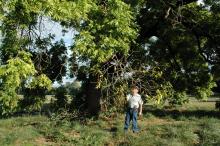Cause A naturally occurring chemical, called juglone, found in black walnuts is toxic to certain plants. Highest concentrations are found in buds, nut hulls and roots. The chemical is not very soluble and accumulates under the canopy of trees. However, damage to pine was noted well beyond the dripline of walnut trees. It is also released by living roots in small amounts and by dead roots as they decay. Other nut trees (such as English walnut, pecan and butternut) produce smaller amounts of juglone.
Plants sensitive to juglone include alder, alfalfa, apple, asparagus, birch, blackberry, blueberry, cabbage, crabapple, eggplant, Kalmia, lilac, magnolia, peony, pepper, potato, pine, privet, rhododendron, rhubarb, silver maple, spruce, and tomato.
Resistant plants include arborvitae, bean, beet, catalpa, cedar, cherry, corn, daffodil, elm, fern, forsythia, hawthorn, hemlock, iris, locust, most maples, oak, onion, orchard grass, pachysandra, pear, rose, sycamore, viburnum and wheat.
Symptoms Plants grow poorly or not at all next to or underneath walnut trees.
Cultural control
- Locate gardens a distance away from walnut trees. A distance of 35 ft is recommended in Loblolly pine stands.
- Do not use walnut leaves or hulls as a mulch around sensitive plants.
References Doggett, C.A., Perry, M. J., and Doggett, W.R. 2016. Black walnut allelopathy in a 28-year-old Loblolly pine stand and implications for initial plantation establishment. Tree Planters' Notes 59:48-51.
Rietveld, W.J. 1983. Allelopathic effects of juglone on germination and growth of several herbaceous and woody species. Journal of Chemical Ecology. 9:295-308.

